The Back
Clinical Conditions
CLINICAL CONDITIONS OF THE MUSCULOSKELETAL SYSTEM
Back pain
Description:
The axial skeleton in an extremely mobile region, it works in conjunction with the ribs to keep the back stable and help protect vital organs, such as the heart and lungs. Back pain once located can be defined as pain that radiates from a specific region in the back and extends throughout or remains regional. Low back, and neck pain are of the two more commonly seen in patients.
Symptoms:
- Sharp pain
- General discomfort in the back
- Stiffness, and numbness radiating from the back into the legs
- Pain that worsens with movement: bending, lifting, standing or walking
Causes:
Back pain can be caused by many things; one being muscle irritation due to the length of the muscles and their many origin and insertion sights. Muscles in the back are prone to developing strains or tightness which can be painful, and difficult to alleviate. The most common cause of back pain is caused by the damage can be of stretching the muscle fibers too far, resulting in tiny tears. These can a result of repeated bending and lifting, and overall poor posture. Another cause of back pain can occur from joint dysfunction, which can happen from sudden natural degeneration due to aging. Others include: ligament strain, bulging or ruptured discs, arthritis and skeletal irregularities such as scoliosis, and kyphosis.
Treatment & Surgical Interventions:
Back pain can be managed with self-care, including rest, adjusting posture, or applying heat or ice. If the pain is still present other treatments such as medication, physical therapy, or manual manipulation of the spine. To assist the back in remaining healthy and strong prioritizing exercise, strength, flexibility, and weight management are tools to manager injury prevention to the back.
Scoliosis
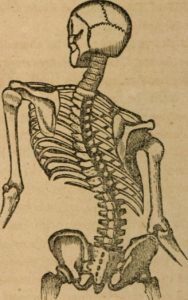
Figure 1. A visualization of scoliosis.
Description:
Scoliosis- is a lateral curvature of the spine that is greater than 10 degrees, it occurs most often during growth spurts. 3 in every 100 people have some form of scoliosis. There are many conditions that can cause scoliosis, a few are; cerebral palsy and muscular dystrophy, however, often the cause of scoliosis is unknown. Majority cases of scoliosis are mild, however some children develop spine deformities that continue to worsen, eventually affecting quality of life. Severe cases can be debilitating. In some cases severe curvature of the spine can reduce the space in the chest cavity resulting in difficulty breathing. Diagnostic imaging is frequently used to diagnose and monitor individual cases.
Symptoms:
- Uneven shoulder
- One shoulder blade appearing more prominent
- Uneven waist
- One Hip higher than the other
- Back prominence
Causes:
Doctors don’t know what cause the most common type of scoliosis, although it appears to involve hereditary factors.
- Idiopathic is a condition that arises spontaneously or from a cause which is unknown. Idiopathic scoliosis is approximately 80% of all scoliosis cases. It typically occurs in adolescent females, it is commonly multidimensional with right thoracic curves. Atypical cases of idiopathic scoliosis are: Found in males, early onset, painful curves, positive neurological signs/symptoms, left thoracic curves, and have rapid progression.
Treatment & Surgical Interventions
- Bracing
- Surgical Interventions
- Posterior Instrumentation and Fusion, Together the procedure immobilize the involved spinal region. Spinal Instrumentation, utilizes surgical procedures to implant titanium, titanium- alloy, stainless steel, or non metallic devices into the spine. Providing a permanent solution to the spinal instability. The implants come in many forms which include, rods, hooks, braided cable, plates, screws, and interbody cages. Spinal Fusion, is a process that uses bone grafts to cause two bony opposing surfaces to grow together. Medical term is arthrodesis. Bone grafts are commonly taken from the patient, but can also come from other individuals
Kyphosis:
Description
Kyphosis is an excessive curvature of the thoracic spine, causing the back to appear “hunched”. It may occur for a number of reasons early in life. The lease frequently develops during puberty and is seen equally in both sexes. These include poor posture, abnormally wedge-shaped shaped vertebrae better known as Scheuermann’s kyphosis. The disease is characterized by kyphosis of the thoracic or thoracolumbar spine. Various diseases can also lead to kyphosis in adults. The most common cause is osteoporosis, a condition where bone mass is lost (mostly in older people). This leaves the spine less able to support the weight of the body, thus resulting in characteristic kyphosis.
Symptoms
- Altered posture, which includes forward head position, and rounded shoulders
- intermittent back pain
- muscle stiffness and fatigue
- decreased flexibility of the torso
- In severe cases, heart and lung functions can be impaired or severe neurological symptoms can occur
Causes
The ethology of Kyphosis is multifactorial, some theories propose juvenile osteoporosis, malabsorption, infection, endocrine disorders and biomedical factors including a shortened sternum. Furthermore, there is strong research to support hereditary influences on the disease.
Treatment & Surgical Interventions
Surgical treatment for Schurermann’s kyphosis is rare, however it is the only way to significantly improve the deformity of the spine. Treatment is based on severity and progression of the curve, the age of an individual, and the present symptomatology. If there is documented progression f the disease surgical interventions should be considered.
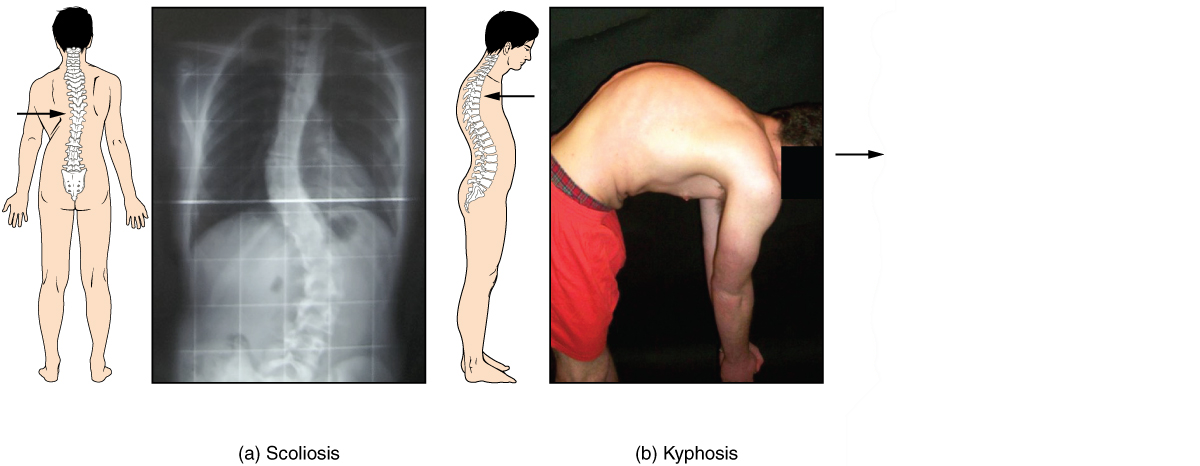
Figure 2. A visualization of scoliosis vs. kyphosis
Sacroiliac Joint Syndrome
Definition:
Sacroiliac Joint Syndrome is another cause of pain found in the lower back. Approximately 15% to 30% of people with low back pain suffer from sacroiliac joint syndrome.
Symptoms:
- Difficulty sitting in one place for a long period of time
- Buttock pain
- Thigh pain
- Local tenderness
- Pain with forward bending
Causes:
The syndrome occurs due to damage of the sacroiliac ligaments resulting in inflammation of the sacroiliac joint. The most common cause is from car accidents, falling on your buttocks, cumulative injuries such as running and aging.
Treatment & Surgical Intervention:
Physical Therapy
Ultrasound, heat and cold, and massage are treatments physiotherapists do during the appointment. They will also send home some core stability and lumbar stabilization exercises.
Injections
A shot of cortisone will help with the inflammation in the joint. Natural ingredients like saline, and numbing drugs is called prolotherapy. It’ll help tighten loose ligaments
Chiropractic treatment
An appointment with a chiropractor will help adjust the muscles and joints to relieve the pain.
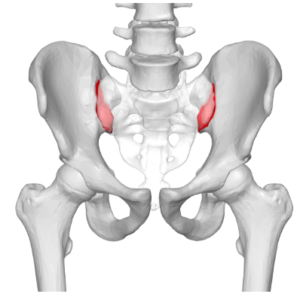
Figure 3. Location of Sacroiliac Joint
Sourced from: https://commons.wikimedia.org/wiki/File:Auricular_surface_of_ilium_02_anterior_view.png
Herniated Disc
Definition:
Accounting for 7% of causes of low back pain, a herniated disc is the next most common. Most herniated discs occur in the lower back, involving the lumbar vertebrae. Herniated discs are known as problems with the intervertebral discs, which are found between each vertebrae of the spine. A herniated disc can be described as the softer centre, the nucleus pulposus, of the disk, pushing out through a tear of the outer edge, the annulus fibrosis.
Symptoms:
- Numbness, tingling, weakness, and pain
- Pain shooting down the leg or arm from coughing, sneezing or moving of the spine is specific positions
Causes:
The cause of injury is most commonly due to gradual, age-related wear and tear. This can be referred to as disk generation, resulting in less flexibility in the vertebrae making it more prone to tearing or rupturing.
Prevention:
There are some methods of prevention that can help reduce the occurrence of herniated discs. This includes exercises that stretch the trunk muscles, maintaining a good posture and maintaining a healthy weight, as excessive weight can result in pressure on the spine and discs.
Treatment & Surgical Intervention:
Physical Therapy
Physical therapists will give positions and exercises which will help minimize the pain.
Surgery
Only a small number of people will need surgery. Surgeons will removed the part of the disk that is protruding. Only in rare cases will the disc need full removal and replacement with an artificial disc.
Medications
Medications will help with the pain and inflammation of the disc. Narcotics, anticonvulsants, muscle relaxers, and cortisone injections are some sections of medications that doctors prescribe patients.
Alternative Medicine
There are some other options for treatment. Chiropractic, acupuncture, massage and yoga will also help with a herniated disc.
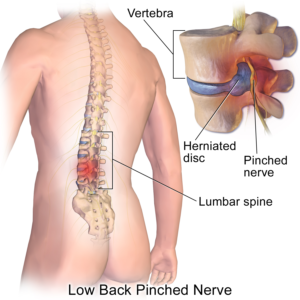
Figure 4. Herniated Disc Sourced from: https://commons.wikimedia.org/wiki/File:Blausen_0484_HerniatedLumbarDisc.png
CLINICAL CONDITIONS OF THE NERVOUS SYSTEM
Sciatica
Definition:
Sciatica is defined by pain along the sciatic nerve. The sciatic nerve is the longest nerve in the body and travels from the lower back down the leg.
Symptoms:
- Pain ranged from mild ache to sharp pain
- Lower back pain
- Buttock pain
- Leg pain and numbness
Causes:
Can be caused by a herniated disk or narrowing of the spine. Any impingement of the sciatic nerve will create sciatica. It can begin quickly and the symptoms can become intermittent or constant.
Prevention:
Preventative measures that can be taken are to exercise regularly to help keep your back strong, focusing on core and lower back muscles. It is also important for prevention to maintain proper posture when sitting as well as to use good body mechanics such as not lifting heavy things mainly using your lower back, or standing for a long period of time.
Treatment & Surgical Intervention:
Mild cases of sciatica will go away on its own.
Acupuncture, physiotherapy and massage therapy have been proven to help with getting blood circulation, muscle relaxation and the release of endorphins which will aid with pain.
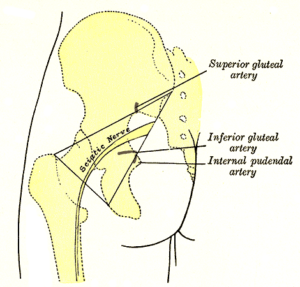
Figure 5. Location of the sciatic nerve

